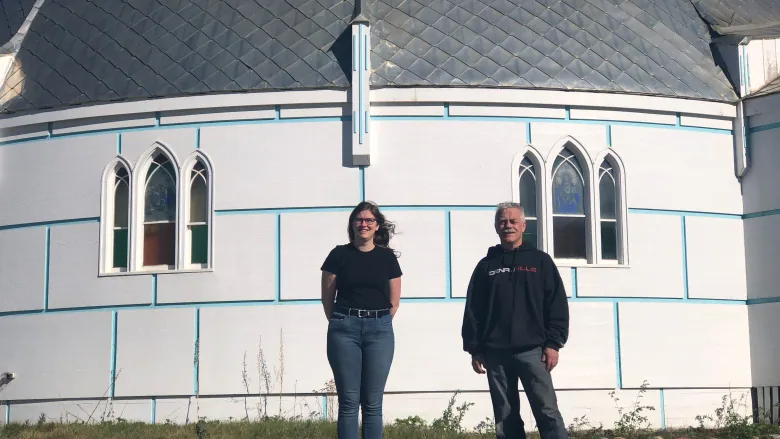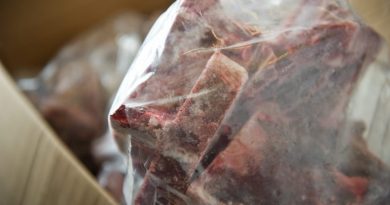How floor repair of ‘igloo church’ in Arctic Canada could offer deeper look into North’s permafrost

The church is no outlier — several buildings in the community are affected by freeze-thaw cycle of permafrost
Even an iconic church is not immune from changing permafrost.
Parishioners at Inuvik’s historic Our Lady of Victory Catholic Church, better known as the igloo church, began to notice the floor was dropping a couple of years ago.
The church was built between 1958 and 1960. Peter Clarkson, is the coordinator of Project Uplift, an effort to restore the church’s foundation and monitor the ground below. He said the foundation was built over a freeze-thaw area.
“They brought in some fill and they put it over top which was probably a tundra/muskeg area, and then poured a cement foundation around the perimeter but also made a cement … almost like a saucer,” Clarkson said.
Vents under the church would allow the cool air in, so thawing that may have occurred in the summer would freeze back every winter.
Clarkson said although the system was working for almost 60 years, it began to be noticeable that “the cement saucer floor has dropped,” a problem, as that was holding up the church floor.
He said there had been very little work done over the years on the structure of the church.
However, last May, the floor was lifted with screw jacks, levelled and insulated thanks to some in-kind donation of services by the Aurora Research Institute and the N.W.T.’s Geological Survey, and $20,000 worth of equipment, for which the church will raise funds to pay for.
Opportunity for scientists
The renovation project is serving as an opportunity for scientists to learn more about what’s going on in the permafrost in the region.
“Any data that we collect is useful for understanding what is the state of permafrost not only under the church but in Inuvik,” said Alice Wilson, a permafrost scientist at the Northwest Territories Geological Survey.
Collecting data and monitoring the church’s foundation is a huge part of the project, she said, and will be used to help the church when it makes further decisions for mitigating any negative impacts on the foundation or floor.

Wilson said they’re looking at the movement underneath the church floor.
That includes signs of subsidence, which is when thawing of the ground causes it to sink, along with heaving, when water in the ground freezes and pushes up certain areas of the church.
“For instance you want to try and avoid having a water pool around foundations because water is a heat sink so that will reduce the amount of heat you can remove throughout the winter,” Wilson said.
“So trying to remove anything that will keep heat in the permafrost is all good steps. Getting it cold in the winter, removing as much heat in the summer. ”
Since permafrost thaw and freeze are long-term events, Wilson said that it’s vital to be as proactive as possible.
Monitoring
Clarkson said Project Uplift is checking the crawl space underneath the church floor every day to see if they have water to pump out.
He said the added insulation that was put in and the equipment, including thermistor chains to monitor the permafrost, that was installed, is working.
“It’s definitely keeping it a lot colder in there now than it was, so we’ll continue to monitor that … in order to preserve the building and the foundation.”
Clarkson said the group will continue to monitor the situation.
“We are in it for the long-term,” he said.
Other buildings affected
The church is not the only building in Inuvik that has experienced changes due to the thawing of permafrost.

Clarkson said Inuvik’s Community Greenhouse floor has also dropped a bit, and some of the roads are “up and down” from the thaw this summer.
The Inuvik pool has had multiple closures partly due to the shifting of the ground impacting the facility, and Inuvik’s hospital is in the process of finding an engineering consultant to remediate and restore the foundation.
James Ross, a representative with the N.W.T. Department of Infrastructure, told CBC News in an email that the hospital, which was built in 2004, “is suffering from inadequate surface drainage around the perimeter of the building.”
“This is allowing water to seep into the crawlspace. The building design incorporated a thermosyphon system to protect the permafrost under the building,” he wrote. “The water seeping into the crawlspace is reducing the system’s ability to keep the ground frozen and is affecting the hospital’s foundation.”
Ross wrote that the request for proposals to fix the foundation and restore the building to its original design elevation recently closed.
Related stories from around the North:
Canada: New research chair at Laval University to help better understand permafrost changes in Arctic Quebec, Eye on the Arctic
Greenland: Tipping points: can a leaked report tip the scales to climate action? Blog by Irene Quaile
Norway: Polar bears face extinction in Svalbard and Arctic Russia says scientist, The Independent Barents Observer
Russia: Putin voices concern about melting permafrost, but doubts it’s caused by humans, The Independent Barents Observer
United States: Bering Sea ice at lowest extent in at least 5,500 years, study says, Alaska Public Media



